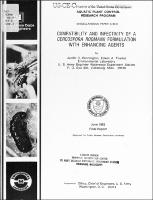Please use this identifier to cite or link to this item:
https://hdl.handle.net/11681/6254| Title: | Compatibility and infectivity of a Cercospora rodmanii formulation with enhancing agents |
| Authors: | Pennington, Judith C. Theriot, Edwin A. |
| Keywords: | Additives Aquatic plant control Biocontrol Biological control Pathogenic fungi Fungal pathogen Cercospora rodmanii Waterhyacinth Aquatic Plant Control Research Program (U.S.) |
| Publisher: | U.S. Army Engineer Waterways Experiment Station |
| Series/Report no.: | Miscellaneous Paper (Aquatic Plant Control Research Program (U.S.)) ; no.Miscellaneous Paper A-83-6 |
| Abstract: | A formulation of the fungus Cercospora rodmanii Conway has been produced by Abbott Laboratories, Chicago, Ill., as a biocontrol of waterhyacinth (Eichhornia crassipes ( Mart.) Solms.). To ensure the most efficient germination of the formulation, 12 potential enhancing agents were tested for addition during the spray application. The agents were aspartic acid, glucose, glutamic acid, gum xanthan, nutrient agar, Ortho X-77 Spreader, Tween 20, Tween-60, Tween 80, sodium alginate, Super Slupper, and yeast extract. Compatibility of test agents and combinations of test agents with two lots of the formulation was determined in the laboratory. All agents tested, except Ortho X-77 Spreader, were compatible with the first lot of formulation and four agents -- Super Slupper, yeast extract, gum xanthan, and aspartic acid -- resulted in significantly greater colony counts than controls. All agents, including Ortho X-77 Spreader, were compatible with the second lot and one agent, sodium alginate, resulted in significantly greater colony counts than controls. All combinations of test agents were compatible with both lots of the C. rodmanii formulation. The C. rodmanii formulation was sprayed with test agents on waterhyacinth pseudolaminae. Damage was monitored each week for 8 weeks by assigning a disease index to each original and new pseudolaminae. No spots having characteristics suggestive of C. rodmanii infection were observed at any time during the study. Microscopic and cultural examinations of pseudolaminae at the end of the study yielded no evidence of infection by the C. rodmanii formulation. Analysis of variance of mean disease indices showed no significant differences between treatments and controls. All results indicated that the C. rodmanii formulation was not infective. Therefore, the effects of test agents on infectivity could not be determined. Lack of infectivity could be remedied by isolating a virulent strain of C. rodmanii from the field. Agents determined to be compatible in this study could then be reexamined for enhancing infectivity on a virulent C. rodmanii formulation. |
| Description: | Miscellaneous Paper |
| Gov't Doc #: | Miscellaneous Paper A-83-6 |
| Rights: | Approved for public release; distribution is unlimited |
| URI: | http://hdl.handle.net/11681/6254 |
| Appears in Collections: | Miscellaneous Paper |
Files in This Item:
| File | Description | Size | Format | |
|---|---|---|---|---|
| MP-A-83-6.pdf | Miscellaneous Paper A-83-6 | 3.11 MB | Adobe PDF |  View/Open |